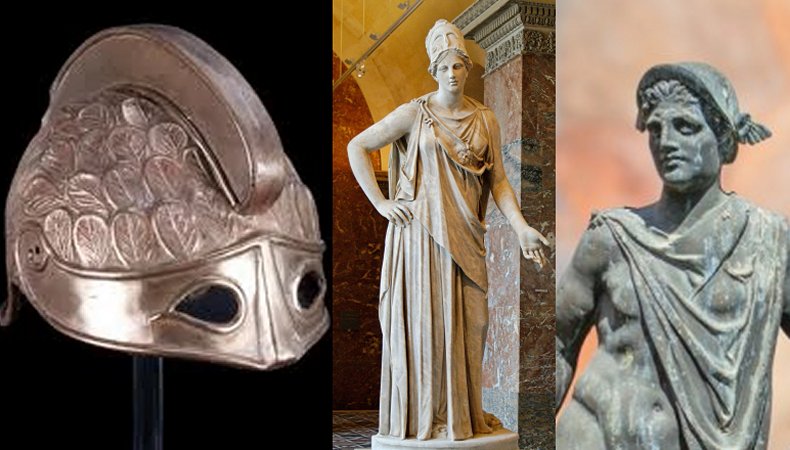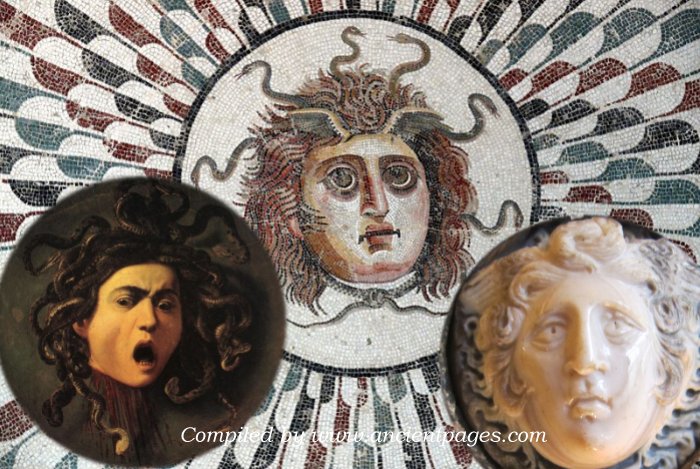Magical Cap Of Invisibility Worn By Athena, Hades, Hermes, And Perseus
Ellen Lloyd- AncientPages.com - Have you ever wanted to become invisible? You may have to wait until an invisibility cloak like Harry Potter's is available in the local store.
Meanwhile, we can always learn about ancient mythological beings who possessed the ability to become invisible at will. In ancient myths and legends, we come across several magical objects that gave a person the ability to become invisible.
Left: A helmet was worn to become invisible. Credit: Public Domain: Middle: Goddess Athena. Credit: Public Domain. Right: God Hermes. Credit: Stock Photo
One of them was the magical Ring of Gyges, which granted its owner the ability to become invisible at will.
The magical ring was perhaps a mythical object, but Gyges existed and was a historical figure, though barely anything is known about his life and reign.
The Cap Of Invisibility is mentioned in Greek mythology. It was a helmet used by the goddess Athena, the gods Hermes and Hades, and the hero Perseus whenever they wanted or needed to become invisible.
After the god Zeus liberated the Cyclops, who had been held as prisoners of Tartarus, the giants wanted to return the favor. They were undoubtedly ugly and frightening to look at, but they were skilled builders and craftsmen.
The Cyclops "went to work, beating metal on the anvil, forging for Zeus the lightning and thunderbolts of his wrath. For Poseidon, they made a huge trident, a three-pronged fork with wicked points. And for Hades, later Lord of the Underworld, they fashioned a cap of invisibility." (Michael Foss - Gods and Heroes: The Story of Greek Mythology)
Perseus Arming Himself. One of the nymphs holds out the kunea, while the others hold a winged sandal and the kibisis. Image credit: Edward Burne-Jones - 1885. Public Domain
Hades was the one who owned the Cap of Invisibility, and he used it when he fought the Titans. Hades was considered especially dangerous when he roamed the Earth wearing his helmet of invisibility.
Goddess Athena wore the Cap of Invisibility on several occasions. During the Trojan War, she had to become invisible so that Ares, the Greek god of war and one of the twelve Olympians, couldn't notice she was helping Diomedes, his enemy.
When the god Hermes was forced to fight the giant Hippolytus, whom he also killed, he wore the Cap of Invisibility.
One of the most famous mythological stories relating how practical the Cap of Invisibility was involves the hero Perseus' slaying of the Medusa monster.
Medusa's fate was sealed once Athena cursed her. As Ancient Pages wrote earlier, Perseus sought Medusa out to defeat her once and for all.
Perseus used the Cap of Invisibility to kill Medusa.
What was tragic for Medusa was that Perseus had some help from the gods. He was given special weapons to defeat her and escape her monstrous siblings. Athena gave Perseus the Cap of Invisibility. Wearing the magical helmet, Perseus could avoid the gorgon's deadly gaze and successfully escape from the immortal monsters Stheno and Euryale after he had decapitated Medusa.
The Cap of Invisibility offered complete protection, and its wearer could hide even from the eyes of supernatural beings.
This fantastic magical object is also known as the Cap of Hades, Helm of Hades, or Helm of Darkness. The ability to become invisible was mentioned in many myths and legends.
In Welsh mythology, we encounter a "Mantle of Invisibility" in the story of Culhwch and Olwen. In German mythology, a dwarf king is the owner of the Tarnkappe, enabling him to become invisible at will. Sometimes, it is said that gods possessed supernatural powers that gave them the ability to vanish into thin air. On other occasions, they used particular objects like the Cap of Invisibility so that no one could see them.
Updated on March 14, 2024
Written by Ellen Lloyd – AncientPages.com
Copyright © AncientPages.com All rights reserved. This material may not be published, broadcast, rewritten or redistributed in whole or part without the express written permission of AncientPages.com
More From Ancient Pages
-
 Nomenclator: Ancient Living-Human Calendar And Address Book
Ancient History Facts | Jul 4, 2018
Nomenclator: Ancient Living-Human Calendar And Address Book
Ancient History Facts | Jul 4, 2018 -
 The Mystery Of The Serpent Seed
Biblical Mysteries | Jul 19, 2019
The Mystery Of The Serpent Seed
Biblical Mysteries | Jul 19, 2019 -
 Unexpected Discovery Of Rare Ancient Roman Carved Wooden Figure In Buckinghamshire
Archaeology | Jun 11, 2022
Unexpected Discovery Of Rare Ancient Roman Carved Wooden Figure In Buckinghamshire
Archaeology | Jun 11, 2022 -
 New Discovery: Unknown Use Of Yellow Colors In Ancient Egypt – Revealed
Archaeology | Oct 16, 2019
New Discovery: Unknown Use Of Yellow Colors In Ancient Egypt – Revealed
Archaeology | Oct 16, 2019 -
 Hidden Byzantine Hoard Offers Evidence Of A Dramatic Historial Event In The Levant
Artifacts | Oct 13, 2022
Hidden Byzantine Hoard Offers Evidence Of A Dramatic Historial Event In The Levant
Artifacts | Oct 13, 2022 -
 Scientists Say Large Mammals Shaped The Evolution Of Humans – Here Is What Happened
Featured Stories | Jan 27, 2023
Scientists Say Large Mammals Shaped The Evolution Of Humans – Here Is What Happened
Featured Stories | Jan 27, 2023 -
 Did Leonardo Da Vinci Invent Contact Lenses In 1508?
Ancient Technology | Dec 10, 2015
Did Leonardo Da Vinci Invent Contact Lenses In 1508?
Ancient Technology | Dec 10, 2015 -
 Ancient Cosmic Event And Unearthed Artifacts May Solve An Enduring Viking Mystery
Vikings | Dec 12, 2024
Ancient Cosmic Event And Unearthed Artifacts May Solve An Enduring Viking Mystery
Vikings | Dec 12, 2024 -
 India: Plastic Surgery And Genetic Science – Found In Ancient Vedas – Were Practiced Thousands Of Years Ago
Ancient Technology | Oct 29, 2014
India: Plastic Surgery And Genetic Science – Found In Ancient Vedas – Were Practiced Thousands Of Years Ago
Ancient Technology | Oct 29, 2014 -
 Mystery Of Charterhouse Warren’s Early Bronze Age Site Solved By Scientists
Archaeology | Dec 27, 2024
Mystery Of Charterhouse Warren’s Early Bronze Age Site Solved By Scientists
Archaeology | Dec 27, 2024 -
 Judas: A Famous Traitor Or A Hero?
Biblical Mysteries | Oct 16, 2017
Judas: A Famous Traitor Or A Hero?
Biblical Mysteries | Oct 16, 2017 -
 Hidden Story Of The Sacred Wiradjuri Carved Trees Revealed
Archaeology | Nov 28, 2023
Hidden Story Of The Sacred Wiradjuri Carved Trees Revealed
Archaeology | Nov 28, 2023 -
 Pandavleni Buddhist Caves: Sculptures, Inscriptions And Sophisticated Water Management System
Civilizations | Dec 8, 2016
Pandavleni Buddhist Caves: Sculptures, Inscriptions And Sophisticated Water Management System
Civilizations | Dec 8, 2016 -
 120-Million-Year-Old Fossil Reveals Early Bird’s Leaf-Eating Habits
Fossils | Aug 8, 2023
120-Million-Year-Old Fossil Reveals Early Bird’s Leaf-Eating Habits
Fossils | Aug 8, 2023 -
 Function Of “Chopping Tools” Found At Prehistoric Site Of Revadim Israel – Studied
Archaeology | Jan 22, 2021
Function Of “Chopping Tools” Found At Prehistoric Site Of Revadim Israel – Studied
Archaeology | Jan 22, 2021 -
 Vindelev Treasure Re-Writes Ancient History – World’s Oldest Runic Inscription Of God Odin Found On Ancient Gold Pendants
Archaeology | Mar 8, 2023
Vindelev Treasure Re-Writes Ancient History – World’s Oldest Runic Inscription Of God Odin Found On Ancient Gold Pendants
Archaeology | Mar 8, 2023 -
 Clay Tablets Of Assyrian ‘King Of The World’ Esarhaddon Found Beneath Biblical Tomb Of Jonah
Archaeology | Mar 1, 2018
Clay Tablets Of Assyrian ‘King Of The World’ Esarhaddon Found Beneath Biblical Tomb Of Jonah
Archaeology | Mar 1, 2018 -
 On This Day In History: Albert Einstein Publishes His General Theory Of Relativity – On Mar 20, 1916
News | Mar 20, 2017
On This Day In History: Albert Einstein Publishes His General Theory Of Relativity – On Mar 20, 1916
News | Mar 20, 2017 -
 What Female Jobs Could Lead To Being Accused Of Witchcraft In Early Modern England?
News | Sep 20, 2023
What Female Jobs Could Lead To Being Accused Of Witchcraft In Early Modern England?
News | Sep 20, 2023 -
 On This Day In History: Viking Forces Laid Siege To Paris – On Nov 25, 885
News | Nov 25, 2016
On This Day In History: Viking Forces Laid Siege To Paris – On Nov 25, 885
News | Nov 25, 2016



